Virgin birth of Jesus
| Part of a series on |
| Christianity |
|---|
 |
|
|
|
The virgin birth of Jesus is the belief that Jesus was conceived in the womb of his mother Mary through the Holy Spirit without the agency of a human father and born while Mary was still a virgin.[1] The New Testament references are Matthew 1:18-25 and Luke 1:26-38; it is not expressly mentioned elsewhere in the Christian scriptures,[2] and "the modern scholarly consensus is that the doctrine of the virgin birth rests on a very slim historical foundation."[3]
The virgin birth was universally accepted in the Christian church and, except for some minor sects, was not seriously challenged until the 18th century. It is enshrined in the creeds that most Christians consider normative, such as the Nicene Creed ("incarnate of the Virgin Mary") and the Apostles' Creed ("born of the Virgin Mary"), and is a basic article of belief in the Catholic, Orthodox, and most Protestant churches.
Muslims also believe in the virgin birth of Jesus.[4]
New Testament references
| Events in the |
| Life of Jesus according to the Gospels |
|---|
 |
|
In rest of the NT |
|
Portals: |
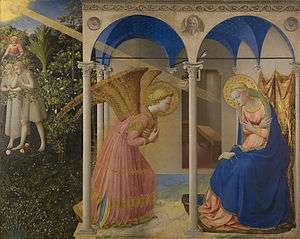
The story of Jesus' miraculous conception by the Holy Spirit is found only in the Gospel of Matthew and the Gospel of Luke.[5]
Matthew
18 Now the birth of Jesus the Messiah took place in this way. When his mother Mary had been engaged to Joseph, but before they lived together, she was found to be with child from the Holy Spirit. 19 Her husband Joseph, being a righteous man and unwilling to expose her to public disgrace, planned to dismiss her quietly. 20 But just when he had resolved to do this, an angel of the Lord appeared to him in a dream and said, "Joseph, son of David, do not be afraid to take Mary as your wife, for the child conceived in her is from the Holy Spirit. 21 She will bear a son, and you are to name him Jesus, for he will save his people from their sins." 22 All this took place to fulfill what had been spoken by the Lord through the prophet:
23 "Look, the virgin shall conceive and bear a son,
and they shall name him Emmanuel,"
which means, "God is with us." 24 When Joseph awoke from sleep, he did as the angel of the Lord commanded him; he took her as his wife, 25 but had no marital relations with her until she had borne a son; and he named him Jesus.[6]
Luke
26 In the sixth month the angel Gabriel was sent by God to a town in Galilee called Nazareth, 27 to a virgin engaged to a man whose name was Joseph, of the house of David. The virgin's name was Mary. 28 And he came to her and said, "Greetings, favored one! The Lord is with you." 29 But she was much perplexed by his words and pondered what sort of greeting this might be. 30 The angel said to her, "Do not be afraid, Mary, for you have found favor with God. 31 And now, you will conceive in your womb and bear a son, and you will name him Jesus. 32 He will be great, and will be called the Son of the Most High, and the Lord God will give to him the throne of his ancestor David. 33 He will reign over the house of Jacob forever, and of his kingdom there will be no end." 34 Mary said to the angel, "How can this be, since I am a virgin?" 35 The angel said to her, "The Holy Spirit will come upon you, and the power of the Most High will overshadow you; therefore the child to be born will be holy; he will be called Son of God. 36 And now, your relative Elizabeth in her old age has also conceived a son; and this is the sixth month for her who was said to be barren. 37 For nothing will be impossible with God." 38 Then Mary said, "Here am I, the servant of the Lord; let it be with me according to your word." Then the angel departed from her.[7]
Origins of the birth stories

Christian tradition prior to Matthew and Luke
Both Matthew and Luke probably date from the period AD 80-100,[8] and both were originally anonymous (the attributions to Matthew and Luke were added in the 2nd century).[9] It is widely, though not universally, accepted that both are based on the Gospel of Mark,[10] but Mark has no birth story,[11] and the differences between Matthew and Luke are so great that it is highly unlikely either comes from the other or that they shared a common independent source.[5] Some scholars, notably Raymond E. Brown, have suggested that Joseph was the source of Matthew's account and Mary of Luke's,[12][13] but modern scholars consider this "highly unlikely", given that this so-called family tradition emerged only at a late stage in the Christian tradition.[14]
Isaiah 7:14
Matthew[15] quotes a prophecy from the Isaiah as the basis for the virgin birth. In this vignette the prophet Isaiah informs King Ahaz that his enemies will be destroyed before a child born to a young woman in his retinue is old enough "to refuse evil and know good;" this child, he says, will be named Immanuel, "God is with us," because God is with Israel:
10 Moreover the LORD spake again unto Ahaz, saying,
11 Ask thee a sign of the LORD thy God; ask it either in the depth, or in the height above.
12 But Ahaz said, I will not ask, neither will I tempt the LORD.
13 And he said, Hear ye now, O house of David; Is it a small thing for you to weary men, but will ye weary my God also?
14 Therefore the Lord himself shall give you a sign; Behold, a virgin shall conceive, and bear a son, and shall call his name Immanuel.
15 Butter and honey shall he eat, that he may know to refuse the evil, and choose the good.
16 For before the child shall know to refuse the evil, and choose the good, the land that thou abhorrest shall be forsaken of both her kings.[16]
Scholars agree that the Hebrew word used in Isaiah, "almah", signifies a girl of childbearing age without reference to virginity,[17] and Isaiah is in any case talking about his own immediate circumstances in the year 735 BC, not the distant future.[18] In Isaiah the Immanuel prophecy has an immediate aim, but Matthew uses it to find patterns of God's dealings with Israel rather than a single and specific fulfillment.[18]
Theology
In the genealogy preceding his birth story the author of Matthew calls Joseph "the husband of Mary, of whom was born Jesus, who is called Christ."[19] In the original Greek, the phrase "of whom", ἐξ ἧς, is feminine singular, clearly showing that it refers to Mary, and that Joseph was not the biological father of Jesus.[20] As the story progresses the Book of Matthew underlines the virginity of Mary through references to the Book of Isaiah (using the Greek translation rather than the Hebrew original) and by his narrative statement that Joseph had no sexual relations with her until after the birth (a choice of words which leaves open the possibility that they did have relations after that).[21]
The Book of Luke differs from Matthew in depicting a virginal conception rather than a virgin birth (there is nothing in Luke that suggests Joseph did not have sexual relations with Mary after the angelic visit).[22]
Luke's virgin birth story is a standard plot from the Jewish scriptures, as for example in the annunciation scenes for Isaac and for Samson, in which an angel appears and causes apprehension, the angel gives reassurance and announces the coming birth, the mother raises an objection, and the angel gives a sign.[23]
Thomas Aquinas wrote that human beings incur original sin through being begotten by the active power in a man's semen.[24] Therefore, he felt, it was proper that Christ assumed flesh from a woman, as "the power of a man's semen ought not to have accomplished the formation of Christ's body."[25]
Origins of Jesus outside the birth narratives
The Pauline epistles make three explicit references to Jesus' birth, and assume Jesus' full humanity and say nothing of the circumstances of the birth.[26] The three are Galatians 4:4, which speaks of Jesus as "born of a woman, born under the law"; Romans 1:1-4, which says that Jesus was "of the seed of David according to the flesh"; and Philippians 2:6-7, in which Jesus is described as "born in the likeness of men".[26] Some scholars have seen Paul's silence as evidence that he was unaware of any virgin birth tradition (Paul wrote several decades before Matthew and Luke).[27]
Paul's expression "born of a woman, born under the law" has been interpreted as implying that Jesus had no human father.[27] The opening of the Epistle to the Romans[28] includes the words: "who was descended from David according to the flesh and was declared to be the Son of God in power according to the Spirit of holiness by his resurrection from the dead, Jesus Christ our Lord". Some, pointing out that the Greek word translated as "descendant" in some Bibles is sperma, which literally means "seed", and interpreting this as indicating descent through the male line,[29] take "descended from David according to the flesh" to mean that Joseph, a descendant of David, was the physical father of Jesus, thus denying the virgin birth of Jesus, others take it as indicating that Mary was also a descendant of David.[30][31][32] Others point out that here, as in Galatians 4:4, Paul does not use the ordinary word for "born" (γεννητός, gennetos, the word used in Matthew 11:11 in relation to John the Baptist being "born of a woman"), but the word γενόμενος, genomenos, literally meaning "become", "come to be",[33][34] a fact that some interpret as an allusion to incarnation of the pre-existent Son of God.[35][36]
In Timothy 1:4, the author urges people not to "occupy themselves with myths and endless genealogies which promote speculations". Some scholars see this passage as reflecting a negative view of the developing virgin birth stories and their variant genealogies.[37]
Quran
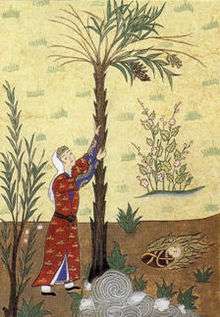
The Islamic faith echoed some strands within Christian tradition that Mary (or Maryam) was a literal virgin when Jesus was conceived. The most detailed account of the annunciation and birth of Jesus is provided in Surah 3 (Al Imran) and 19 (Maryam) of the Quran where the story is narrated that God (Allah) sent an angel to announce that Maryam could shortly expect to bear a son, despite being a virgin.[38]
Some academics have noted that the account in Surah 19[39] is particularly close to that in the Christian Gospel of Luke.[40] The Annunciation to Mary is mentioned twice in the Quran and in both instances Mary/ Maryam is told that she was chosen by God to deliver a son. In the first instance, the bearer of the news (who is believed by most Muslims to be the archangel Gabriel), delivered the news in (3:42-47) as he takes the form of a man (19:16-22).[41][42] The details of the conception are not discussed but when Mary asks how she can bear a son in view of her chastity she is told that God creates what he wills and that these things are easy for God.[41][43] The Quran (21:91 and 66:12) says that God blew through his angel into Mary and she, although being chaste bore Jesus without any father.[44][45]
Historicity
The modern scholarly consensus is that the doctrine of the virgin birth rests on a very slim historical foundation.[3] According to Matthew, an angel appears to Joseph in a dream, to inform Joseph of the virginal conception; while in Luke the angel Gabriel informs Mary before the conception occurs. There are at least two rival explanations for the "double attestation" of Matthew and Luke regarding the virgin birth of Jesus:[46][47]
- The virgin birth was a historical event, and the narratives of Matthew and Luke are based on different aspects of the event according to witnesses' reports of it.[48]
- Matthew and Luke both wanted to present Jesus as fulfilling prophecies from Hebrew scripture. Both were aware of prophecies concerning a virgin birth and Bethlehem, and therefore these elements of their stories match. But each author wove these prophecies into an overall narrative in a different way. For example, both authors had to explain how Jesus was born in Bethlehem when he was known to be from Nazareth (as mentioned in all four gospels)—and each came up with an independent explanation.[49]
However, the fact that the virgin birth is mentioned only by Matthew and Luke is considered to produce doubt as to its truth by scholars such as Jürgen Moltmann. He writes: "In the New Testament, Christ's 'virgin birth' is related only by Luke and Matthew. It was unknown, or considered unimportant, in wide areas of early Christian belief (the Pauline and Johannine sectors, for example). But from the third century onwards it became a firm component of the Christian creeds and theological christologies." He also writes: "The virgin birth is not one of the pillars that sustains the New Testament faith in Christ. The confession of faith in Jesus, the Son of God, the Lord, is independent of the virgin birth, and is not based on it." "Moreover, we find the confession of faith in Christ in Christian traditions which know nothing of the virgin birth, or do not mention it." He concludes: "that the virgin birth does not provide the justification for confessing Christ."[50] John L. McKenzie notes that, if these two narratives were missing from the New Testament, "there would be no biblical mention of the virgin birth". He adds, "the event is unusual enough for one to wonder why an author who knew of it would not mention it."[51] Bart D. Ehrman writes, "The tradition that Jesus' mother was a virgin is given by both Matthew and Luke, and to that extent, it's independently attested. But it has always struck scholars as odd that the tradition—which surely would be an important thing to know!—isn't attested anywhere else in our earliest sources, even among writers who would have had a real interest in publicizing the fact that God himself was actually Jesus' father."[52] The Oxford Companion to the Bible, on the fact that nowhere else in the Bible is the virgin birth attested, has:
Such an argument from silence cannot be determinative, but it is an important consideration for people who see the virgin birth as a feature created within the early traditions about Jesus rather than a historical occurrence. Those who doubt the historicity of the virgin birth argue that it was created by the early church as a way of honoring the coming of Jesus as the Son of God or of explaining the idea of God becoming flesh. Miraculous human birth stories are common in biblical tradition, going back to Abraham and Sarah (Gen. 17.15—19, 18.9—15, I. 1—7), and numerous references to deities impregnating women are found within the Greco-Roman tradition. The mother of Heracles, for instance, was said to have been impregnated by Zeus (Diodorus Siculus, 4-9, 1—10).[53]
Among other hypotheses that have been proposed as explanations of the origin of the accounts in Matthew and Luke of the birth of Jesus from a virgin is that of professor of humanities and religious studies Stephen L. Harris, who proposed that these were written to answer Jewish slanders about Jesus' illegitimate birth,[54] of which there is evidence from the 2nd century, but which may have been a subsequent polemical Jewish response to the account in Matthew and Luke.[55] Helmut Köster views the narratives of Jesus' virgin birth as having roots in Hellenistic mythology.[56]
Denial of the virgin birth
Throughout Christian history a small number of groups have denied the virgin birth.[57] This view existed among some early Jewish Christian groups such as some of the Ebionites who considered Jesus the Messiah, but rejected the apostle Paul as an apostate.[58] However, in the 4th century the Nicene Creed rejected the teaching that Jesus was a mere human.[59]
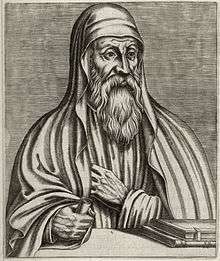
In the 2nd century, Celsus, a pagan anti-Christian Greek philosopher, wrote that Jesus's father was a Roman soldier named Pantera. The views of Celsus drew responses from Origen, who considered it a fabricated story.[60][61] Raymond E. Brown states that the story of Pantera is a fanciful explanation of the birth of Jesus which includes very little historical evidence.[62]
In the Middle Ages, as part of the conflicts with Christians, a satirical parody of the Christian gospels called the Toledot Yeshu was written. The book referred to Pantera, or Pandera, as the father of Jesus.[63][64][64][65][66][66] Robert E. Van Voorst states that the literary origins of Toledot Yeshu cannot be traced with any certainty, and that, given its medieval composition without a fixed form, it is "most unlikely" to contain reliable historical information.[67] The Blackwell Companion to Jesus states that the Toledot Yeshu contains no historical facts as such, and was perhaps created as a tool for warding off conversions to Christianity.[68]
Historically notable figures to deny the virgin birth included the translator of the first Bible in Belarusian, Symon Budny (who was excommunicated by the Polish Unitarians[69]), and Joseph Priestley and Samuel Taylor Coleridge in the 18th and 19th centuries.[70][71]
Cultural context
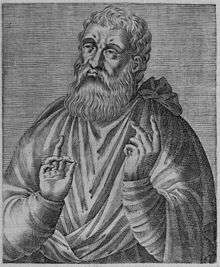
In 1st-century Judea, Jewish girls were betrothed around the age of twelve or twelve and a half.[72] During the betrothal period, which lasted about a year, the marriage was not consummated and the bride remained in her parents' house.[73] Betrothal was formalised by a contract, and voiding the contract required a divorce document freeing the girl to remarry.[74]
The ancient world had no idea that male semen and female ovum were both needed to form a fetus; instead they thought that the male contribution in reproduction consisted of some sort of formative or generative principle.[75] According to the understanding of the time, Mary's bodily fluids would provide all the matter that was needed for Jesus' bodily form, including his male sex.[76]
Tales of virgin birth and the impregnation of mortal women by deities were well known in the 1st-century Greco-Roman world,[73] and Second Temple Jewish works were also capable of producing accounts of the appearances of angels and miraculous births for ancient heroes such as Melchizedek, Noah, and Moses.[77] Nevertheless, "plausible sources that tell of virgin birth in areas convincingly close to the gospels' own probable origins have proven extremely hard to demonstrate".[78] Similarly, while it is widely accepted that there is a connection with Zoroastrian (Persian) sources underlying Matthew's story of the Magi (the wise men from the East) and the Star of Bethlehem, a wider claim that Zoroastrianism formed the background to the infancy narratives has not achieved acceptance.[78]
As part of the conflicts between Christians and other groups during the 1st and 2nd centuries, statements were made by both Jews and pagans criticizing the Christian virgin birth narratives.[79] Early Christian Justin Martyr countered these arguments in The First Apology of Justin and Dialog with Trypho.[80] Perhaps intending to make Jesus' virgin birth more palatable to non-Christians, Justin argued that "the extraordinary birth of Jesus is something that He has in common with Perseus". However, Justin also says that such pagan stories were given them by Satan, and the stories were not really virgin births.[81]
The early Christian document The Ascension of Isaiah, which may date to the 2nd century, also has a narrative of the virgin birth of Jesus.[82] However, the date and origin of this document are questionable, given that the author disguised his identity behind Isaiah.[83] The narrative of the virgin birth of Jesus can be found also in other New Testament apocrypha, for instance the Protevangelium of James, perhaps written in the 2nd century.[84]
Christian celebrations and devotions
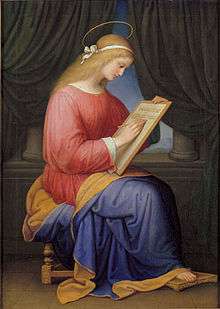
Christians celebrate the conception of Jesus on 25 March[85] (Lady Day) and his birth at Christmas (25 December) or Epiphany (6 January). Among the many traditions associated with Christmas are the construction of cribs and the performance of re-enactments of elements of the story in the Gospels of the birth of Jesus, a tradition started in the 13th century by the Franciscans.[86][87][88]
The festival of the Nativity which later turned into Christmas was a 4th-century feast in the Western Church, notably in Rome and North Africa, although it is uncertain exactly where and when it was first celebrated.[89] There has been debate about the reason why Christians came to choose the 25 December date to celebrate the birth of Jesus. One theory is that they did so in order to oppose the existing winter-solstice feast of the Natalis Solis Invicti (Birthday of the Unconquered Sun) by celebrating on that date the birth of the "Sun of Righteousness".[90]
Another tradition derived the date of Christmas from that of the Annunciation, the virginal conception of Jesus.[90] Since this was supposed to have taken place on 14 Nisan in the Jewish calendar, calculated to have been either 25 March or 6 April, it was believed that the date of Christ's birth will have been nine months later.[91] A tractate falsely attributed to John Chrysostom argued that Jesus was conceived and crucified on the same day of the year and calculated this as 25 March, a computation also mentioned by Saint Augustine of Hippo.[90]
The Magnificat, based on Luke 1:46-55 is one of four well known Gospel canticles: the Benedictus and the Magnificat in the first chapter, and the Gloria in Excelsis and the Nunc dimittis in the second chapter of Luke, which are now an integral part of the Christian liturgical tradition.[92][93][94] The Magnificat is one of the eight most ancient Christian hymns and perhaps the earliest Marian hymn.[95][96] The Annunciation, representing the virgin birth, became an element of Marian devotions in Medieval times, and by the 13th century direct references to it were widespread in French lyrics.[97]
The Eastern Orthodox Church uses the title "Ever Virgin Mary" as a key element of its Marian veneration, and as part of the Akathists (hymns) to Mary which are an integral part of its liturgy.[98]
Artistic depictions
This doctrine of the Virgin Birth is often represented Christian art in terms of the annunciation to Mary by the Archangel Gabriel that she would conceive a child to be born the Son of God, and in Nativity scenes that include the figure of Salome. The Annunciation is one of the most frequently depicted scenes in Western art.[99] Annunciation scenes also amount to the most frequent appearances of Gabriel in medieval art.[100] The depiction of Joseph turning away in some Nativity scenes is a discreet reference to the fatherhood of the Holy Spirit, and the doctrine of Virgin Birth.[101]
Gallery of art
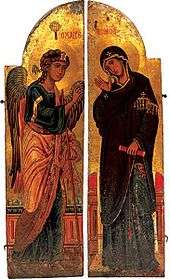 Holy Doors, Saint Catherine's Monastery on Mount Sinai in Egypt, 12th century
Holy Doors, Saint Catherine's Monastery on Mount Sinai in Egypt, 12th century Sandro Botticelli (1489–90)
Sandro Botticelli (1489–90)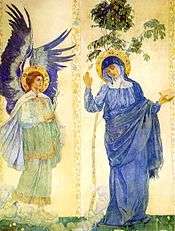 Mikhail Nesterov, Russia, 19th century
Mikhail Nesterov, Russia, 19th century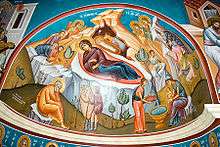 Eastern Orthodox Nativity depiction little changed in more than a millennium
Eastern Orthodox Nativity depiction little changed in more than a millennium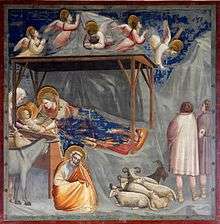 Giotto (1267–1337): Nativity with an uninvolved Joseph but without Salome
Giotto (1267–1337): Nativity with an uninvolved Joseph but without Salome
See also
References
- ↑ Dorman, T.M. (1995), "Virgin Birth", in Bromiley, Geoffrey W., International Standard Bible Encyclopedia: Q-Z, Eerdmans, p. 990, ISBN 978-0802837844
- ↑ Barth, Karl (2004), Church Dogmatics: The doctrine of the word of God, A&C Black, p. 175, ISBN 978-0567050694
- 1 2 Bruner, Frederick (2004) [1st ed. 1987], Matthew: The Christbook, Matthew 1-12, Eerdmans, p. 37, ISBN 978-0802811189
- ↑ Britannica (2007). "Virgin Birth". Encyclopædia Britannica Online.
- 1 2 Hurtado, Larry W. (2010), Lord Jesus Christ: Devotion to Jesus in Earliest Christianity, Eerdmans, p. 318, ISBN 978-0802831675
- ↑ Matthew 1:18-25
- ↑ Luke 1:26-38
- ↑ Boring, M. Eugene; Craddock, Fred B. (2009), The People's New Testament Commentary, Westminster John Knox Press, pp. 12, 105, 175, 467, ISBN 978-0664235925
- ↑ Fredriksen, Paula (2008), From Jesus to Christ: The Origins of the New Testament Images of Jesus, Yale University Press, p. 7, ISBN 978-0300164107
- ↑ France, R.T (2007), The Gospel of Matthew, Eerdmans, p. 20, ISBN 978-0802825018
- ↑ Davidson, John (2005), The Gospel Of Jesus: In Search Of His Original Teachings, Clear Press, p. 82, ISBN 978-1904555148
- ↑ Hurtado, Larry W. (2010), Lord Jesus Christ: Devotion to Jesus in Earliest Christianity, Eerdmans, p. 322, ISBN 978-0802831675
- ↑ Brown, Raymond E. (1973), The Virginal Conception and Bodily Resurrection of Jesus, Paulist Press, p. 61, ISBN 978-0809117680
- ↑ Lincoln, Andrew (2013), Born of a Virgin?, Eerdmans, p. 144, ISBN 978-0802869258
- ↑ 1:23
- ↑ Isaiah 7:10–16
- ↑ Sweeney, Marvin A (1996), Isaiah 1–39: with an introduction to prophetic literature, Eerdmans, p. 161, ISBN 978-0802841001, retrieved 2014-07-20
- 1 2 France, R.T (2007), The Gospel of Matthew, Eerdmans, pp. 56–57, ISBN 978-0802825018
- ↑ [1:16]
- ↑ Turner, David L. (2008), Matthew, Baker, p. 3, ISBN 978-0-8010-2684-3
- ↑ Morris, Leon (1992), The Gospel According to Matthew, Eerdmans, pp. 31–32, ISBN 978-0851113388
- ↑ Simmons, Paul D. (1990), "Virgin Birth", in Mills, Watson E.; Bullard, Roger Aubrey, Mercer Dictionary of the Bible, Mercer University Press, p. 948, ISBN 978-0865543737
- ↑ Kodell, Jerome (1992), "Luke", in Karris, Robert J., The Collegeville Bible Commentary: New Testament, NAB, Liturgical Press, pp. 939–940, ISBN 978-0814622117
- ↑ Thomas Aquinas (2003), Brian Davies, ed., On Evil, translated by Richard Regan, Oxford University Press, p. 225, ISBN 978-0199882748
- ↑ Aquinas, Thomas (2009). Compendium of Theology By Thomas Aquinas. translated by Richard J Regan. Oxford University Press, Inc. pp. 175–178. ISBN 978-0-19-538530-4.
- 1 2 Lincoln, Andrew (2013), Born of a Virgin?, Eerdmans, p. 21, ISBN 978-0802869258
- 1 2 Meier, John P. (1991), A Marginal Jew: Rethinking the Historical Jesus, I, Anchor Bible, p. 226, ISBN 978-0385264259
- ↑ Romans 1:1-4
- ↑ Carlson, Paul (1995) "New Testament Contradictions"
- ↑ Stevens, George Barker (1899), The Theology of the New Testament, T&T Clark, p. 391
- ↑ Brunner, Emil; Wyon, Olive (2003), The Mediator: A Study of the Central Doctrine of the Christian Faith, Lutterworth Press, p. 361, ISBN 0-7188-9049-3
- ↑ Sullivan, Clayton (2002), Rescuing Jesus from the Christians, Trinity Press International, p. 40, ISBN 9781563383809
- ↑ Lockyer, Herbert, All the Doctrines of the Bible (Zondervan 1964 ISBN 0-310-28051-6), p. 43.
- ↑ Guthrie, Donald, Testament Theology (Intervarsity Press 1981 ISBN 0-85111-742-2), p. 371.
- ↑ Perry, Tim S.; Abraham, William J. (editors), Mary for Evangelicals, Intervarsity Press 2006 ISBN 978-0-8308-2569-1, p. 25.
- ↑ Hurtado, Larry W. (2010), Lord Jesus Christ: Devotion to Jesus in Earliest Christianity, Eerdmans, p. 324, ISBN 0-8028-3167-2
- ↑ Barrett, J. Edward (1988). "Can Scholars Take the Virgin Birth Seriously?" Bible Review, October, pp. 10-15, 29.
- ↑ Sarker, Abraham,Understand My Muslim People, 2004, ISBN 1-59498-002-0, p. 260.
- ↑ [Quran 19:1]
- ↑ Jackson, Montell, Islam Revealed, 2003, ISBN 1-59160-869-4, p. 73.
- 1 2 Peters, F. E., Islam: A Guide for Jews and Christians, 2005, Princeton University Press, ISBN 0-691-12233-4, p. 23.
- ↑ Jestice, Phyllis G., Holy people of the world: a cross-cultural encyclopedia, Volume 1, 2004, ISBN 1-57607-355-6, pp. 558–559
- ↑ "Surah Maryam [19:21]". Surah Maryam [19:21]. Retrieved 2018-04-26.
- ↑ "Surah Al-Anbya [21:91]". Surah Al-Anbya [21:91]. Retrieved 2018-04-26.
- ↑ "Surah At-Tahrim [66:12]". Surah At-Tahrim [66:12]. Retrieved 2018-04-26.
- ↑ Eugene Laverdiere (2006) The Annunciation to Mary, Liturgy Training Press, ISBN 978-1-56854-557-8, p. 48.
- ↑ Machen, Gresham (1987) Virgin Birth of Christ, Ingram Press, ISBN 978-0-227-67630-1, p. 252.
- ↑ Gromacki, Robert, 2002, The Virgin Birth Kregel, ISBN 978-0-8254-2746-6, p. 214.
- ↑ Marchadour, A., Neuhaus, D. and Martini, CC., The Land, the Bible, and History: Toward the Land That I Will Show You, Fordham University Press, 2009, ISBN 978-0823226610, pp. 67–68.
- ↑ Moltmann, J., The Way of Jesus Christ, SCM Press, London, 1990, pp. 78-79.
- ↑ McKenzie, J.L., The New Testament Without Illusion, Wipf and Stock Publishers, 2009, ISBN 978-1606082720, pp. 108–109.
- ↑ Ehrman, B. D., Jesus: Apocalyptic Prophet of the New Millennium, Oxford University Press, 1999, ISBN 978-0199839438, p. 96.
- ↑ Metzger, B. M. and Coogan, D., The Oxford Companion to the Bible, Oxford University Press, 1993, ISBN 978-0199743919, p. 790.
- ↑ Harris, Stephen L., Understanding the Bible, McGraw-Hill, 2002, ISBN 978-0767429160.
- ↑ Brown, Raymond E., The Birth of the Messiah. Doubleday & Company. 1977, Appendix V: The Charge of Illegitimacy, ISBN 978-0385059077, p. 537
- ↑ Köster, Helmut Ancient Christian gospels: their history and development, SCM Press, 1990, ISBN 978-0334024590, p. 306.
- ↑ McGuckin, John Anthony, The Westminster handbook to patristic theology, 2004, ISBN 0-664-22396-6, p. 286.
- ↑ Paget, James Carleton, Jews, Christians and Jewish Christians in Antiquity, 2010, ISBN 3-16-150312-0, p. 360.
- ↑ Marthaler, Berard L., The creed: the apostolic faith in contemporary theology, 2007, ISBN 0-89622-537-2, p. 129.
- ↑ Origen; Henry Chadwick, Contra Celsum, 1980, ISBN 0-521-29576-9, p. 32.
- ↑ Patrick, John, The Apology of Origen in Reply to Celsus, 2009, ISBN 1-110-13388-X, pp. 22–24.
- ↑ Raymond Edward Brown, et al.Mary in the New Testament, 1978, ISBN 0-8091-2168-9, p. 262.
- ↑ Michael J. Cook Jewish Perspectives on Jesus Chapter 14 in "The Blackwell Companion to Jesus" edited by Delbert Burkett 2011 ISBN 978-1-4443-2794-6
- 1 2 Chilton, Bruce; Evans, Craig A., Studying the historical Jesus: evaluations of the state of current research, 1998, ISBN 90-04-11142-5, p. 450.
- ↑ Toledot Yeshu (A chronicle of Jesus from a negative and anti-Christian perspective), Princeton University, Retrieved 2015-01-14.
- 1 2 William Horbury, The Depiction of Judeo-Christians in the Toledot Yeshu in "The image of the Judaeo-Christians in ancient Jewish and Christian literature", Doris Lambers-Petry, ed., 2003, ISBN 3-16-148094-5, pp. 280–285.
- ↑ Van Voorst, Robert E (2000). Jesus Outside the New Testament: An Introduction to the Ancient Evidence William B. Eerdmans Publishing Co. ISBN 0-8028-4368-9 pp. 122, 127 and 128
- ↑ Michael J. Cook, Jewish Perspectives on Jesus, Chapter 14 in "The Blackwell Companion to Jesus", edited by Delbert Burkett, 2011. ISBN 978-1-4443-2794-6.
- ↑ The Jews in old Poland, 1000-1795 ed. Antony Polonsky, Jakub Basista, Andrzej Link-Lenczowski - 1993 p32 "Budny rejected the eternality of Christ and, in the notes to his translation of the New Testament, denied the Virgin birth, assenting that Jesus was Joseph's son. Even among heretical leaders Szymon Budny was considered a heretic and they would have nothing to do with him
- ↑ Cyclopædia of Biblical, theological, and ecclesiastical literature, Volume 2 By John McClintock, James Strong 1894 p404
- ↑ Bowers, J. D., Joseph Priestley and English Unitarianism in America, 2007, ISBN 0-271-02951-X, p. 36.
- ↑ Deiss, Lucien (1996), Joseph, Mary, Jesus, Liturgical Press, p. 25, ISBN 978-0814622551
- 1 2 Lachs, Samuel T. (1987). A Rabbinic Commentary of the New Testament: the Gospels of Matthew, Mark and Luke. KTAV Publishing House. p. 6. ISBN 978-0881250893.
- ↑ Saldarini, Anthony (2003), "Matthew", in Dunn, James D.G.; Rogerson, John William, Eerdmans Commentary on the Bible, Eerdmans, p. 1007, ISBN 978-0802837110
- ↑ Lincoln, Andrew (2013), Born of a Virgin?, Eerdmans, p. 196, ISBN 978-0802869258
- ↑ Lincoln, Andrew (2013), Born of a Virgin?, Eerdmans, p. 258, ISBN 978-0802869258
- ↑ Casey, Maurice (1991), From Jewish Prophet to Gentile God: The Origins and Development of New Testament Christology, Westminster John Knox Press, p. 152, ISBN 9780664227654
- 1 2 Welburn, Andrew J (2008), From a Virgin Womb: The "Apocalypse of Adam" and the Virgin Birth, BRILL, p. 2, ISBN 9789004163768
- ↑ Goodman, M.; Sherwood. J., Roman world, 44 B.C.-A.D. 180, Routledge, 1997, ISBN 0-415-04969-5, page 326.
- ↑ Bromiley, Geoffrey W., The International Standard Bible Encyclopedia, 1995, ISBN 0-8028-3785-9, p. 271.
- ↑ Machen, J. Gresham, Virgin Birth of Christ, James Clarke & Co, 1987, p. 335, ISBN 0-227-67630-0.
- ↑ Machen, J. Gresham, Virgin Birth of Christ, 1987, ISBN 0-227-67630-0, p. 42.
- ↑ Hurtado, Larry W., Lord Jesus Christ, 2005, ISBN 0-8028-3167-2, p. 595.
- ↑ Bromiley, Geoffrey W., International Standard Bible Encyclopedia: A-D, 1995, ISBN 0-8028-3781-6, p. 182.
- ↑ The Julian Calendar 25 March corresponds at present to 8 April in the Gregorian Calendar.
- ↑ Brooke, Rosalind B., The image of St Francis, 2006, ISBN 0-521-78291-0, pp. 183–184.
- ↑ Thomas, George Finger, The vitality of the Christian tradition, 1944, ISBN 0-8369-2378-2, pp. 110–112.
- ↑ The tradition of Catholic prayer, by Christian Raab, Harry Hagan, St. Meinrad Archabbey, 2007, ISBN 0-8146-3184-3, pp. 86–87.
- ↑ Vischer, Lukas, Christian worship in Reformed Churches past and present, 2002, ISBN 0-8028-0520-5, pp. 400–401.
- 1 2 3 Oxford Dictionary of the Christian Church (Oxford University Press 2005 ISBN 978-0-19-280290-3), article Christmas
- ↑ Procter and Frere's New History of the Book of Common Prayer (see The Date of Christmas and Epiphany)
- ↑ Robert Kugler, Patrick Hartin An Introduction to the Bible, William B. Eerdmans Publishing Co., 2009, ISBN 0-8028-4636-X, p. 394
- ↑ Mills, Watson E.; Bullard, Roger Aubrey, Mercer dictionary of the Bible, 1998, ISBN 0-86554-373-9, p. 396.
- ↑ Sanctity of time and space in tradition and modernity by Alberdina Houtman, Marcel Poorthuis, Joshua Schwartz, 1998, ISBN 90-04-11233-2, pp. 61–62.
- ↑ Breed, David R.,The History and Use of Hymns and Hymn-Tunes, 2009, ISBN 1-110-47186-6, p. 17.
- ↑ Reeves, Marjorie, Favourite Hymns, 2006, ISBN 0-8264-8097-7, pp. 3–5.
- ↑ O'Sullivan, Daniel E., Marian devotion in thirteenth-century French lyric, 2005, ISBN 0-8020-3885-9, pp. 14–15.
- ↑ Peltomaa, Leena Mari, The image of the Virgin Mary in the Akathistos hymn, 2001, ISBN 90-04-12088-2, p. 127.
- ↑ Guiley, Rosemary, The encyclopedia of angels, 2004, ISBN 0-8160-5023-6, p. 183.
- ↑ Ross, Leslie, Medieval art: a topical dictionary, 1996, ISBN 0-313-29329-5, p. 99.
- ↑ Grabar, André, Christian iconography: a study of its origins, 1968, Taylor & Francis, p. 130.
Further reading
- Brown, Raymond E. (1999), The Birth of the Messiah: A Commentary on the Infancy Narratives in the Gospels of Matthew and Luke (no preview), Yale University Press, ISBN 978-0300140088
- Carroll, John T. (2012), Luke: A Commentary, Westminster John Knox Press, ISBN 978-0664221065
- Chouinard, Larry (1997), Matthew, College Press, ISBN 978-0899006284
- Cohen, Jonathan (1993), The Origins and Evolution of the Moses Nativity Story, BRILL, ISBN 978-9004096523
- Coyle, Kathleen (1996), Mary in the Christian Tradition (revised ed.), Gracewing Publishing, ISBN 978-0852443804
- Koester, Helmut (2000) [1982], Introduction to the New Testament: History and literature of early Christianity (2nd ed.), Walter de Gruyter, ISBN 978-0-567-16561-9
- Marsh, Clive; Moyise, Steve (2006), Jesus and the Gospels (2nd ed.), A&C Black, ISBN 978-0567040732
- Miller, John W. (2008), "The Miracle of Christ's Birth", in Ellens, J. Harold, Miracles, ABC-CLIO, ISBN 978-0275997236
- Sawyer, W. Thomas (1990), "Mary", in Mills, Watson E.; Bullard, Roger Aubrey, Mercer Dictionary of the Bible, Mercer University Press, ISBN 978-0865543737
- Weaver, Rebeccah H. (2008), "Jesus in early Christianity", in Benedetto, Robert; Duke, James O, The New Westminster Dictionary of Church History: The early, medieval, and Reformation eras, Westminster John Knox Press, ISBN 978-0664224165
Virgin birth of Jesus | ||
| Preceded by Gabriel announces John's birth to Zechariah |
New Testament Events |
Succeeded by Mary visits Elisabeth |
.jpg)